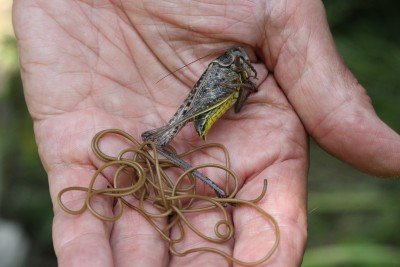
Here’s the thing: wolf worms are actually the larvae of a fly known as the **wolf fly** (not to be confused with the adorable canines!). This relationship might seem gross, but it’s a vital part of the ecosystem. In this article, we’ll dive into how these extraordinary creatures survive inside their hosts and how they eventually emerge. Trust me, it’s a story worth your time.
What Are Wolf Worms?
Wolf worms, or **cuterebra**, are the larval stage of a specific type of flies. These flies lay their eggs on or near rodent nests. Once hatched, the larvae find their way into the rodent’s skin, where they live and grow. Picture it like a tiny, uninvited guest that settles in for an extended stay.
These larvae can be found in various rodent species, including mice, squirrels, and even rabbits. You might be wondering why such a gross-sounding parasite is essential to understand. Well, they play a role in controlling rodent populations, which ultimately helps maintain a balance in nature.
Life Cycle of Wolf Worms
Let’s break down how wolf worms develop. It all starts with a female wolf fly laying her eggs near a rodent burrow. When the eggs hatch, the tiny larvae are looking for a warm spot to stay. They latch onto a rodent, often crawling through the fur and into the skin.
This phase is crucial for their survival. Once inside, the larvae create a small hole, allowing them to breathe while they munch away at the host’s tissues. It’s a bit like having a meal delivered right to your door! This process can go on for several weeks, as the larvae grow significantly and take advantage of their cozy arrangement.
But what happens next? Eventually, these larvae reach maturity. This is the exciting part — they’re ready to leave their rodent hosts and continue their life cycle.
How Do Wolf Worms Emerge?
Emerging from their host is no small feat. When the larvae are fully grown, they create a larger opening in the rodent’s skin—think of it as a tiny exit door. This process can be a bit gruesome. If you’ve ever seen a gruesome movie, picture that—but for real life! Once they emerge, they drop to the ground, ready to find a spot to pupate.
This part of their life cycle is essential for transforming from larvae into adult flies. They burrow into the soil, where they undergo metamorphosis. It’s in this stage that they develop wings and other adult features. The cycle then continues as the adult flies find new hosts to lay their eggs on.
Effects on Their Rodent Hosts
You might be asking, “What happens to the rodents?” Well, the impact of wolf worms can vary. Some rodents manage to survive despite having these parasites. Others might experience health issues or even die, especially if the infestation is severe.
Think about it like this: having these larvae is like having a really unwanted roommate. They take resources and can cause significant discomfort. In some cases, if a rodent is particularly unlucky, the infection can lead to severe consequences.
The good news? Not all rodents get severely impacted. Many develop a certain level of resistance, which means they can live relatively normal lives even while hosting these tiny tenants.
Where Are Wolf Worms Found?
Wolf worms are most commonly found in regions with abundant rodent populations. They tend to thrive in rural areas, fields, and wooded regions. Places where rodents burrow or nest are prime locations for these fascinating parasites.
If you’re in an area with a lot of wild rodents, there’s a chance wolf worms are lurking nearby. It’s like a hidden side of nature that many people don’t usually consider. Whether you’re out on a hike or in your backyard, it’s interesting to think about what might be happening under the surface!
How Do Wolf Worms Affect Ecosystems?
Despite their creepy nature, wolf worms actually play an important role in maintaining ecosystem balance. By infesting rodent populations, they help prevent overpopulation, which can lead to issues like starvation and habitat destruction. In a way, they’re nature’s little regulators.
Consider this: if rodent populations were left unchecked, they could cause significant agricultural issues or compete with other wildlife for resources. By controlling these populations, wolf worms contribute to a healthier environment overall.
How to Deal with Wolf Worm Infestations in Pets
If you’re a pet owner, especially if you have cats or dogs that like to hunt rodents, you might be concerned about wolf worm infestations. Here are some tips to keep in mind:
- Monitor your pets: Keep an eye out for unusual behavior, as this can indicate a problem.
- Vet visits: Regular check-ups can help catch any infestations before they become severe.
- Prevention: Keeping your yard clean and rodent-free can reduce the likelihood of encounters.
- Awareness: Educate yourself about signs of infestations so you can act quickly.
Understanding how wolf worms work and their life cycle not only helps you better comprehend the natural world but also encourages responsible pet ownership.
Wolf worms might seem like a horror story waiting to happen, but they play a unique role in the ecosystem and the lives of rodents. From their astonishing life cycle to their impact on rodent hosts, these parasites offer a fascinating glimpse into nature’s complex web.
Next time you see a mouse scurrying along, you might think twice about what could be happening beneath its fur. Understanding creatures like wolf worms helps us appreciate the intricacies of nature. So whether you’re an animal lover, a curious mind, or just someone who stumbled upon this article, I hope you found this topic as intriguing as I do. Nature is wild—and that’s what makes it so fascinating!
